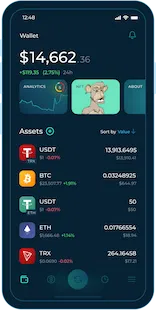How to Choose Cryptocurrencies to Invest In?
Jan 16, 2023There are over two hundred tokens and coins in the Arctic wallet and the number keeps growing. But how to decide which cryptocurrencies are worth buying? The answer is always ‘DYOR'. When you start in crypto, you hear this a lot. But what does that even mean? How do you do your own research?
Let's finally uncover points to analyze in order to make a reasonable decision on whether to purchase a specific token or not and some tools to help you with that.
| Image Source: Arctic Wallet App |
What is DYOR?
DYOR basically means proper research a person performs to avoid relying on someone's preconceived opinions regarding a certain crypto project and cryptocurrency. The goal is to approach crypto investment with a cool head and avoid FOMO & hype influence.
Due diligence in crypto means researching the fundamentals of the project behind the token:
- to make sure the token is backed by a sustainable project that is able to keep the token value up;
- to evaluate the risks;
- to spot rug pulls and pump-and-dump schemes not to get scammed and REKT.
Analyzing Crypto Projects in 6 Steps
Let's divide the project analysis into the six most vital components to check before investing in any cryptocurrency. What questions should be answered prior to deciding to buy any token?
1. Value of the project
First, it's good to zoom out and read the website and white paper to get insights on the project's overall mission:
- Does the project offer a unique solution to a real-world problem? If the team claims to somehow “change the future of crypto” and gives no clear indication how, that's truly suspicious.
- Is it a copycat of another crypto startup? Is the approach unique? And if not, how it's better than competitors in a similar segment?
- What use cases does the token have? — What makes or will make people buy and utilize it, generate transactions, and want to hold long-term?
2. Analyzing Documentary
- Does it have a whitepaper and roadmap at all? No-whitepaper policy isn't serious.
- Are there reports or regular updates on milestones already hit? Or it's all about promises, missed deadlines, and no real action.
- What development stage the project is in right now? And more importantly, are there any long-term plans in the roadmap showing how determined the team is to deliver?
3. Understanding token economics
Tokenomics is the imperative section in the white paper. It gives an insight on tokens supply; market capitalization; share of tokens given to the team members, investors, and general public; and so on. The token with poor token economics is NGMI — almost predestined to fail.
Some questions to ask here:
- Is the token release and distributing schedule long and slow enough to avoid creating sell pressure?
- Is the percentage of overall supply given to developers and private investors too big a chunk to cause troubles?
- Are enough tokens allocated to incentivize the network participants?
- Are there sufficient amounts allocated to fund the project development?
| Image Source: CoinGecko |
4. Who's in the Core Team
Nothing can stop anonymous founders from dumping the project and disappearing with the money. So, we want to see a doxxed (public) team with LinkedIn profile links on the website for further research:
- Do the team members have relevant experience in the field? Were they involved in successful tech/finance/crypto product launches in the past?
- Are chief executives experienced enough in supervising the projects not to ruin it all with faulty leadership decisions?
- Are there advisors knowledgeable in relevant spheres that can add up value to the team?
5. Community
- Are community members passionate about the project?
- Do they participate in explicit discussions?
On that, it's worth reading into the comments: constructive arguments are a way better indicator than ‘good project', ‘X coin to the moon', or ‘wen Lambo'-type comments. These may be shillers paid to imitate some activity.
- Is the team in contact with the community? Do they welcome feedback and react to positive criticism?
6. Verification
- Does the team spread misinformation?
For example, about being featured on top media outlets like Forbes, Bloomberg, CoinDesk, etc.; or about partnerships without confirmation from the alleged partner. News verification takes a little effort but saves a lot of time in uncovering scammers.
Additional Sources to Help
As pointed out above, the project research should include an in-detail website, white paper, and roadmap analysis. But it's also valuable to get information from lots of different resources to then make your own decision.
There are some free resources to guide you on the way:
- Messari.io, which posts crypto analytical content and financial reports with key metrics and their interpretation;
- Coinmarketcap.com and Coingecko.com display price history, tokenomics, ranking, official links, and basic information.
- Glassnode.com is sharing on-chain data charts with explanations.
- Lunarcrush.com gives an understanding of how the crypto community feels about the project and token.
| Image Source: Messari |
The Bottom Line
Bear market is a quiet and longish period, yet, perfect for spending it on education and market research. It's also an opportunity to accumulate gems at lower prices. Doing your due diligence may take up a lot of time but that's the key to taking wiser unbiased investment decisions.


